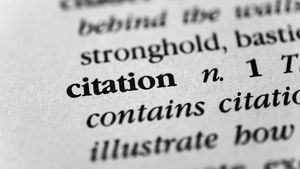More actions
m Added image. |
m Tweaked cats. |
||
| (2 intermediate revisions by the same user not shown) | |||
| Line 3: | Line 3: | ||
I’m pretty tired of it. It seems that only in academic writing do we still languish in the print age with our needlessly complex documentation styles. Why can’t there be a straight-up style for documenting in hypertext that does not bow down to a print tradition? In short: | I’m pretty tired of it. It seems that only in academic writing do we still languish in the print age with our needlessly complex documentation styles. Why can’t there be a straight-up style for documenting in hypertext that does not bow down to a print tradition? In short: | ||
[[File:Citation .jpg|thumb]] | [[File:Citation .jpg|thumb]] | ||
{{Big|We need a citation style for the screen.}} | |||
Asking students for “MLA style” has always been problematic, and I think this is only becoming worse as fewer actual physical books are used as resources. Students didn’t do it very well when they were just composing essays on dead trees, and now that much of their writing is done online, they are even more confused. | Asking students for “MLA style” has always been problematic, and I think this is only becoming worse as fewer actual physical books are used as resources. Students didn’t do it very well when they were just composing essays on dead trees, and now that much of their writing is done online, they are even more confused. | ||
| Line 34: | Line 34: | ||
This is my modest proposal. Check out my current (still in beta) [[Digital Citation|practical guide to digital citation]]. I’d love to hear ideas from other educators and scholars on Twitter with the hashtag #DigitalCitation, or leave a comment somewhere. | This is my modest proposal. Check out my current (still in beta) [[Digital Citation|practical guide to digital citation]]. I’d love to hear ideas from other educators and scholars on Twitter with the hashtag #DigitalCitation, or leave a comment somewhere. | ||
== Note == | ===== Note ===== | ||
{{Reflist}} | {{Reflist}} | ||
[[Category: | [[Category:Composition]] | ||
[[Category: | [[Category:New Media]] | ||
[[Category:Technoculture]] | |||
Latest revision as of 15:29, 23 July 2020
TL;DR: Styles written for a print culture have no place in a digital one. Let’s stop teaching for print media.[1] |
I’m pretty tired of it. It seems that only in academic writing do we still languish in the print age with our needlessly complex documentation styles. Why can’t there be a straight-up style for documenting in hypertext that does not bow down to a print tradition? In short:

We need a citation style for the screen.
Asking students for “MLA style” has always been problematic, and I think this is only becoming worse as fewer actual physical books are used as resources. Students didn’t do it very well when they were just composing essays on dead trees, and now that much of their writing is done online, they are even more confused.
And I don’t blame them. Citation styles like MLA, APA, and Chicago are meant for documenting print resources within print documents. Frankly, they can’t seem to keep up. They publish new rules every year in their reference manuals that try in vain to keep up with every new medium that might be quoted or referenced. When the citation for a tweet is longer and more complex than the actual tweet I’m citing, something’s amiss. These are citation styles for the world of dead trees. They had a good run. Let’s retire them. Please.
Are they still useful for print documents? I suppose, but they are getting cumbersome, especially when we add electronic sources with greater frequency. Besides, I’m not even certain when I last asked students to print and turn in a paper essay to me. Sure some of them want to do that, especially non-traditionals (usually sending multiple follow up emails “did ya get my essay?!”), but most are fine emailing an RTF or PDF for evaluation. In these crossover documents, give me embedded and clickable URLs every time.
Hypertext should make citing sources easy and intuitive, but because academics insist on citation dinosaurs, students want to make this process much more complicated than it needs to be. Why put an MLA-formatted list of works cited at the bottom of a blog entry — especially when all of the sources are URLs? And why make these ugly things visible? Nothing says “amateur” more than a pasted-in, non-clickable URL on a web site. Yet, MLA tells them to do it because the style still favors print. Are people really printing blog posts? If so, why?
Stop the madness. If we aren’t teaching students how to link — especially in writing classes — then we aren’t doing our jobs. Indeed, the logic of linking — not to mention the secondary literacy it requires — could be more of a creative, higher-function skill than just inserting a parenthetical citation. The eloquent use of links requires additional rhetorical considerations, like context, scan-ability, maximum density, and word choice. No, we don’t link words like “here,” and we needn’t send folks to Webster’s online for a definition of “lexia.” Yet, a clear allusion or direct reference should send a reader directly to that reference, if she so desires to undertake the journey.
Now don’t get me wrong: I’m not suggesting that we throw out citations altogether. In fact, if the connected world makes anything even more clear to me, we actually need to emphasize the importance of support and development in student writing. Unlike print text, anyone can post any dumbheaded thing online, so part of being digitally literate is also knowing what to cite. With print, this was less of an issue, since the gatekeepers did a pretty good job, once upon a time, keeping the wackos out of the library stacks. Now the wackaloons might actually be running the show — which begs the question: why are we academics still publishing in print journals and hiding behind long publication times and esoteric databases? (OK, this is another issue, but still one that’s relevant and should be thoughtfully debated. Especially in an age of Digital Humanities, our uninhibited access to resources becomes increasingly important. More on this below.)
I guess my basic argument is this: let’s stop teaching only for paper media. Let’s embrace writing for digital media and use the best practices for these, including what they do best: intertextuality. Conventions like footnotes, endnotes, and in-text citations should easily be incorporated within the text, linking directly to the clearest support or resource.
If we start by considering just what we expect and need out of a clear citation style, we might begin to posit one for a digital world. It seems to me that documenting sources in a consistent and predictable way allows for:
- Access — easy and direct links to support and resources;
- Argument — author credibility and document development;
- Context — participation in an ongoing conversation;
- Usability — document design and presentation.
I figure the reason that traditional citation styles were divided into different components were also for these very reasons: imagine putting complete references within the body of the text. It would render it unreadable; but this is not the case with digital texts. Likewise, a works cited page or annotated bibliography would allow a separate space for complete reference details, précis, or commentary — again something that would not be necessary in a digital document, unless it was another layer of information the author wanted to add.
For example, if I want to cite a particular passage of Norman Mailer’s “The White Negro,” why can’t I do so by linking either to the print source sitting by my elbow, say with a parenthetical citation à la MLA (Mailer 341), or actually link to the electronic version of the very text I’m using, say at the Internet Archive. From these direct links, any additional information that a reader needed could be gleaned from the resources, or the whole work could be read if it’s available. The works cited page is the Internet itself, not pointers to other libraries that contain the implicit too bad this reference is not accessible to you. Our job is to find the links that are the most accurate and complete. Obviously the full text of the resources would be the best, but then how would the corporations ever get paid?
I don’t think this means that annotated bibliographies are useless, but they could be so much more. And just because we list the complete print information in a works cited page does not give it any more permanence than a current link. Print only gives the illusion of permanence, something that still has some caché in academia. You know, just like dead trees.
This is my modest proposal. Check out my current (still in beta) practical guide to digital citation. I’d love to hear ideas from other educators and scholars on Twitter with the hashtag #DigitalCitation, or leave a comment somewhere.
Note
- ↑ Originally written on December 18, 2013.
